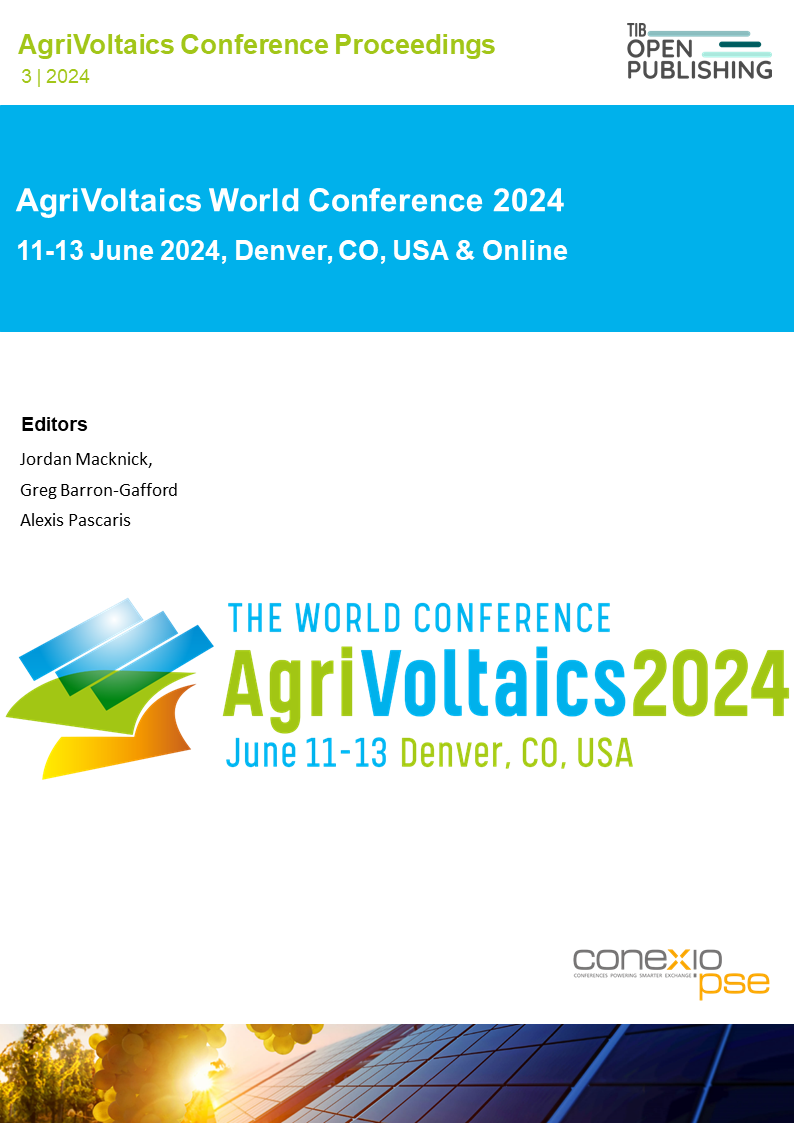South-Oriented PV Trackers: A Solution for Tree Plantations?
DOI:
https://doi.org/10.52825/agripv.v3i.1394Keywords:
Agronomic Tracking, Irradiance Modelling, Single-Axis Trackers, Agrivoltaics, Perennial CropsAbstract
Single-axis trackers in AgriVoltaics (APV) systems traditionally face East-West (E-W) to track the sun's path. This study investigates the viability of North-South (N-S) oriented trackers for optimising irradiance distribution in tree plantations. Using a modelling framework and meteorological data from Aix-en-Provence, France, we demonstrate that N-S trackers create distinct shading patterns on the ground that shift throughout the year due to varying solar zenith angles. By strategically positioning photovoltaic (PV) panels relative to tree canopies, our simulations show potential for minimising shading on sun-loving crops like apricot trees, crucial for maintaining photosynthesis levels. We propose innovative tracking algorithms to mitigate shading effects during different seasons, preserving both electrical output and agricultural productivity. Our simulations indicate that N-S trackers offer comparable electricity production to E-W configurations in sun-tracking mode and outperform fixed arrays-oriented South, with minimal losses in irradiance during critical growth periods. Additionally, N-S trackers show promise in reducing soil evaporation, which could enhance water balance in agricultural settings. Future research employing 3D modelling and integrated PV-crop simulations is recommended to optimise design parameters and assess the Land Equivalent Ratio (LER) for further validation.
Downloads
References
G. Lopez, J. Chopard, S. Persello, P. Juillion, V. Lesniak, G. Vercambre, ... & D. Fumey, “Agrivoltaic systems: an innovative technique to protect fruit trees from climate change,” in XXXI International Horticultural Congress (IHC2022): International Symposium on Innovative Perennial Crops Management 1366, Aug. 2022, pp. 173–186, doi: 10.17660/ActaHortic.2023.1366.20.
B. Valle et al., “Increasing the total productivity of a land by combining mobile photovoltaic panels and food crops,” Appl Energy, 2017, doi: 10.1016/j.apenergy.2017.09.113.
V. Quaschning and R. Hanitsch, “Irradiance calculation on shaded surfaces,” Solar Energy, vol. 62, no. 5, pp. 369–375, May 1998, doi: 10.1016/S0038-092X(98)00018-8.
M. A. Mikofski, R. Darawali, M. Hamer, A. Neubert, and J. Newmiller, “Bifacial Performance Modeling in Large Arrays,” Conference Record of the IEEE Photovoltaic Specialists Conference, pp. 1282–1287, Jun. 2019, doi: 10.1109/PVSC40753.2019.8980572.
W. F. Holmgren, C. W. Hansen, and M. A. Mikofski, “pvlib python: a python package for modeling solar energy systems,” J Open Source Softw, vol. 3, no. 29, p. 884, Sep. 2018, doi: 10.21105/JOSS.00884.
F. J. Casares de la Torre, M. Varo-Martinez, R. López-Luque, J. Ramírez-Faz, and L. M. Fernández-Ahumada, “Design and analysis of a tracking / backtracking strategy for PV plants with horizontal trackers after their conversion to agrivoltaic plants,” Renew Energy, vol. 187, pp. 537–550, 2022, doi: 10.1016/j.renene.2022.01.081.
E. Daoud, J. Cheron, J.-B. Pasquier, “Integrating functional–structural plant models for accurate simulation of shade heterogeneity effects on intercepted light and leaf temperature,” in Poster presented at Agrivoltaics 2024, Denver, USA, 2024.
E. Perez, B. Tiffon-Terrade, P. Souquet, J.-B. Pasquier, “Agrivoltaics design assessment through dual modelling of electricity production and agronomic outputs,” in Poster presented at Agrivoltaics 2024, Denver, USA, 2024.
Published
How to Cite
Conference Proceedings Volume
Section
License
Copyright (c) 2025 Jean-Baptiste Pasquier , Jules Chéron, Farida Amichi

This work is licensed under a Creative Commons Attribution 4.0 International License.
Accepted 2025-01-16
Published 2025-05-26
